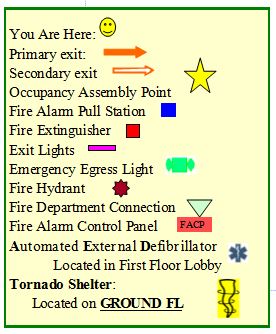Building Evacuation Information

Each building has an Area Coordinator or in residential buildings an REC and RA. This person is responsible for knowing:
- The designated tornado / severe weather area for their building
- The location of fire pull stations on their floor
- Their occupancy assembly points outside of their building
- Their primary and secondary emergency escape routes
- A general knowledge of where people are typically located on their designated floor
- The location of and proper use of a fire extinguisher
- If applicable, the location of first aid supplies and equipment such as an AED and Evacuation Chair.
Area Coordinators / REC will complete the Fire Evacuation Form as soon as the evacuation event is clear and submit it to
Evacuations: If the fire alarm sounds everyone is required to leave the building and report to the Assembly Point where the building's REC, Area Coordinator or an RA will take a head-count and report to Campus Police anyone who appears to be missing.
Occupancy Assembly Points: Every building has an outdoor area assigned where the occupants are required to report to any time the building is evacuated. The location can be found on the Evacuation Map at each exit. The Occupancy Assembly Point will be away from the building in an area that will not interfere with Emergency Responders.
Areas of Refuge: This location should be an interior room or area such as a hallway or bathroom, that does not have any windows or other glass, and is located on the lowest floor of the building. A sign depicting a tornado is located in these locations. Each building will have at least 1 severe weather location identified.
The building's severe weather location is identified on the building's evacuation maps.
Egress Maps are required to be posted at the entrance to stairwells, all exits and are located on the back of residential doors leading to the hallway.
Some of the items the maps indicate are:
- Primary Evacuation Route
- Secondary Evacuation Route
- Occupancy Assembly Point
- Location of Pull Stations
- Location of Fire Extinguishers
- Area of refuge in the event of severe weather
- Location of AED (Automated External Defibrillator).
